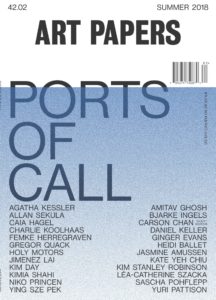Ports of Call
Share:
If I were to formulate a theory of the port, as Sascha Pohflepp begins to do at the close of this issue, it would describe a place of transference, a situated point of exchange, the movement of goods, people, and information tied to a spot. It’s where things go from one place to another. The theory of the port would be a theory of communication founded in architecture. When Victoria Camblin asked me to guest edit the “port cities” issue of ART PAPERS, her last issue with the magazine, I was acquainting myself with my new laptop’s USB-C ports (see Stephen Froese’s review of USB-C). More than just a metaphorical misuse of terms, there is a theoretical through line between the harbor port, port city, airport, free port, and computer port that nevertheless resists simplification.
at the close of this issue, it would describe a place of transference, a situated point of exchange, the movement of goods, people, and information tied to a spot. It’s where things go from one place to another. The theory of the port would be a theory of communication founded in architecture. When Victoria Camblin asked me to guest edit the “port cities” issue of ART PAPERS, her last issue with the magazine, I was acquainting myself with my new laptop’s USB-C ports (see Stephen Froese’s review of USB-C). More than just a metaphorical misuse of terms, there is a theoretical through line between the harbor port, port city, airport, free port, and computer port that nevertheless resists simplification.
“Ports of Call” explores the mixed-cultural, intercultural, and transcultural legacies of the port and how these narratives are articulated in the arts and humanities today. Just as ports are places of exchange, the main form of discourse here is dialectical. Ideas in this issue flow mainly through dialogues, interviews, and roundtables. Architect Bjarke Ingels tells me about his storm surge barrier for lower Manhattan, which featured in the new novel about New York after the oceans have risen by science-fiction writer Kim Stanley Robinson, who, in conversation with Gregor Quack, reveals that he took issue with a characterization of “serious fiction” by novelist Amitav Ghosh, who in turn tells curator Heidi Ballet new ways to imagine a world sinking into the ocean. The water world is never far when contemplating the port. Artists Femke Herregraven and Daniel Keller expand on the fluidity of ideas surrounding underwater cables, seasteading, and the way they manifest in global financing and art. Art historians Kimia Shahi and Ying Sze Pek examine the aesthetics of water trade—Shahi through 19th-century Cantonese export art, Pek through the oceanic work of Allan Sekula.
A port city is a place defined by other places. Defined by changing boundaries that shift with the weather and planetary cycles. What delimits the port—both how it’s geographically demarcated and how it’s defined—is as continuously mutable as the creolized cultures it supports. The brutal commingling of commerce and people harden in Jasmine Amussen’s rumination on America’s historic slave trade. Hong Kong collective Holy Motors contemplates the culture around counterfeit goods—or shui huo, “water goods”—in extended captions of artworks they’ve exhibited; Caia Hagel discusses the cultures of Rotterdam’s immigrant populations with Charlie Koolhaas; and architecture historian Léa-Catherine Szacka writes on the temporality of Venice, the Adriatic port that once traded spices and now markets culture.
What’s it like to be in a place predicated on movement? In Agatha Kessler’s conversation with airport directors Kim Day (Denver International Airport) and Ginger Evans (until recently, O’Hare and Midway airports), the airport is a civic institution, a destination in its own right. In Yuri Pattison’s accompanying photos, the same place appears more like what anthropologist Marc Augé has called a nonplace. For architect Jimenez Lai, from whom Art Papers has commissioned a special project, the airport is both a spatialization of transport logistics (complete with flow lines) and a portal—a threshold to unknown places. The texts and images in this issue are ports of call, intermediary points to reload, unload, and refuel. The whole issue—including Sunny Park and Scott Langer’s design—constitutes a theory of the port.
Carson Chan is a curator and writer currently pursuing a PhD at Princeton University School of Architecture. His current research tracks the rise of environmentalism and aquarium architecture in postwar United States. In 2006 he cofounded PROGRAM, a non-profit project space and residency for art and architecture in Berlin. He has organized more than 50 exhibitions internationally. He co-curated the 4th Marrakech Biennale in 2012, served as the executive curator of the Biennial of the Americas in Denver in 2013, and in 2015 he was guest curator for Dallas Aurora public art biennial. Carson’s writing on architecture, art, and contemporary culture appears regularly in books and publications such as ART PAPERS, Avery Review, Frieze, Log, Pin-Up, Texte zur Kunst, as well as Kaleidoscope, where he is Contributing Editor, and 032C, where he served as Editor at Large.